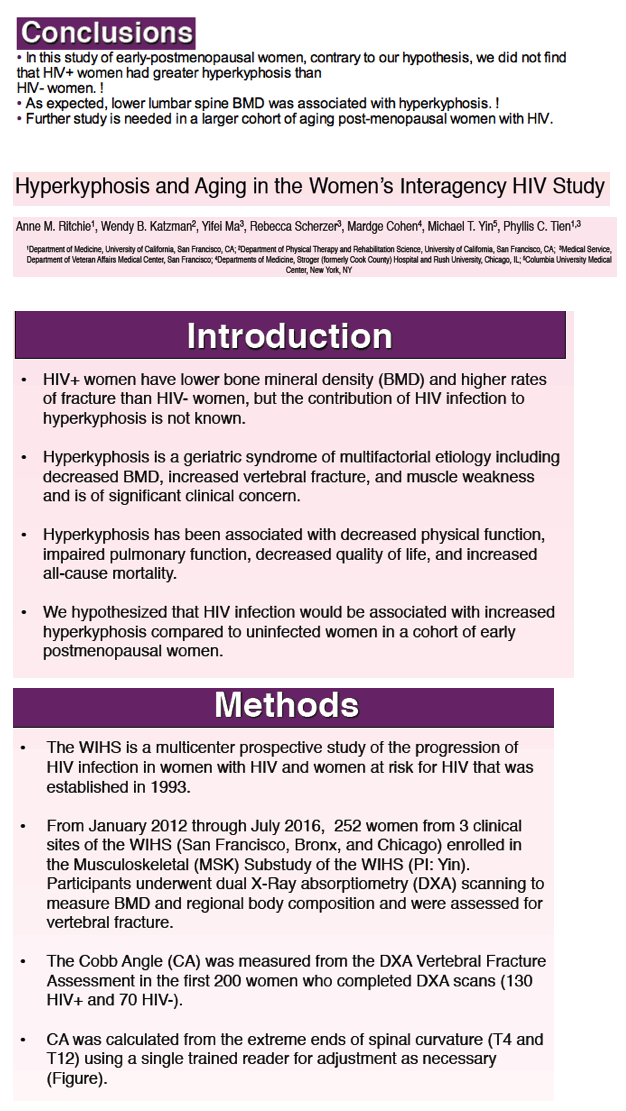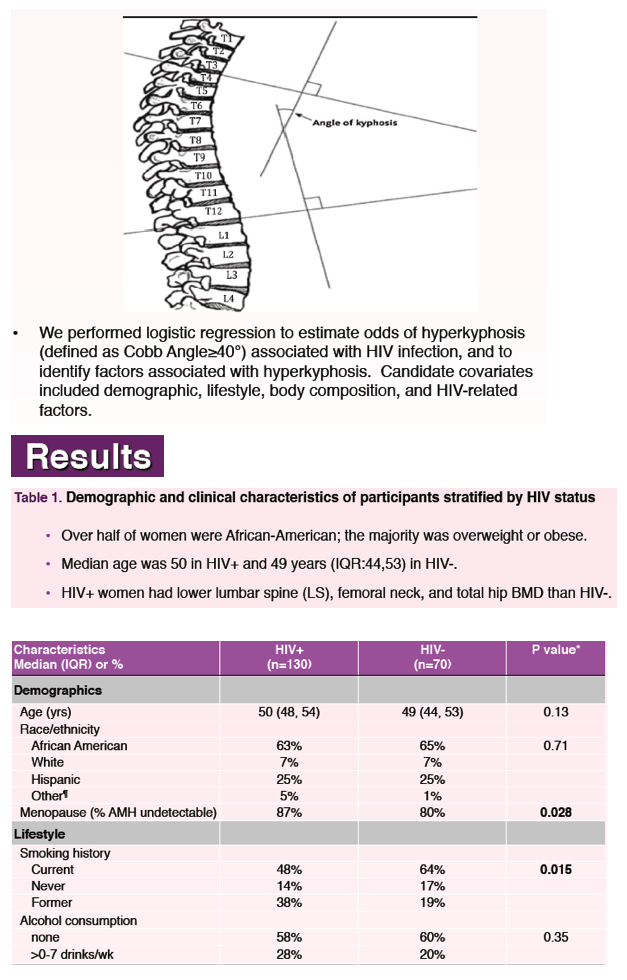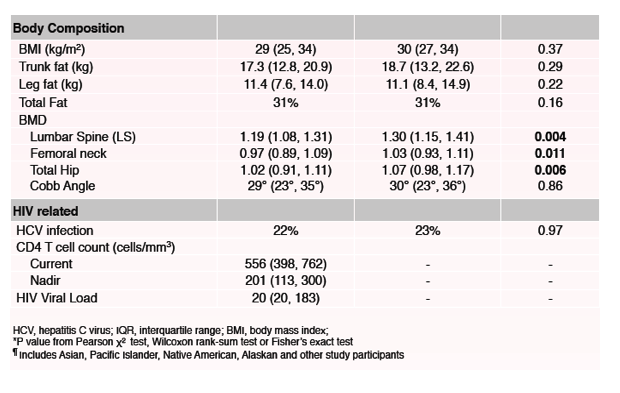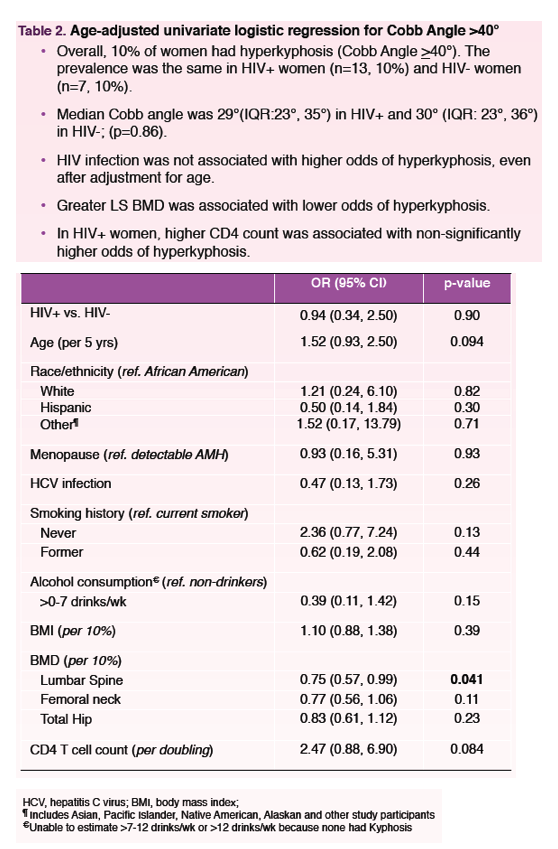 |
 |
 |
| |
Hyperkyphosis and Aging in the Women's Interagency HIV Study
|
| |
| |
Greater Spine Density Cuts Odds of Hyperkyphosis in WIHS Women--HIV Not a Factor
25th Conference on Retroviruses and Opportunistic Infections (CROI), March 4-7, 2018, Boston
Mark Mascolini
HIV infection did not raise chances of hyperkyphosis among older women in the Women's Interagency HIV Study (WIHS) [1]. Greater spine bone mineral density (BMD) lowered odds of hyperkyphosis, curvature of the thoracic spine sometimes called Dowager's hump [2].
Women with HIV have lower BMD and higher fracture rates than HIV-negative women. Both factors may contribute to hyperkyphosis. University of California, San Francisco (UCSF) researchers who conducted this study noted that multiple factors may contribute to hyperkyphosis, including decreased BMD, increased vertebral fracture, and muscle weakness. Hyperkyphosis can lead to decreased physical function, impaired pulmonary function, decreased quality of life, and greater all-cause mortality.
Hyperkyphosis is a geriatric syndrome of multifactorial etiology including decreased BMD, increased vertebral fracture, and muscle weakness and is of significant clinical concern.
To determine whether HIV infection heightens risk of hyperkyphosis, the UCSF team compared 130 WIHS women with HIV and 70 HIV-negative women in WIHS, an ongoing observational study of HIV-positive women and sociodemographically similar women without HIV. From January 2012 through 2016, a subset of women had DXA scans as part of the WIHS Musculoskeletal Substudy. The UCSF team used DXA data to determine Cobb angle for each woman, defining hyperkyphosis as a Cobb angle at or above 40 degrees. They used logistic regression to explore potential association between HIV and hyperkyphosis and to define other hyperkyphosis risk factors.
These early-postmenopausal HIV-positive and negative women were similar in age (medians of 50 and 49 years) and body mass index (29 and 30 kg/m2), and similar proportions were black (63% and 65%). A lower proportion of women with HIV were current smokers (48% versus 64%, P = 0.015). Among women with HIV median nadir and current CD4 counts were 201 and 556, while median viral load stood at 20 copies.
Hyperkyphosis affected 10% of women with HIV and 10% without HIV. Median Cobb angle was nearly identical in the two groups (29 and 30 degrees). Regression analysis did not link HIV to higher odds of hyperkyphosis, even after adjustment for age. In women with HIV, every twice-higher CD4 count nonsignificantly boosted odds of hyperkyphosis (odds ratio [OR] 2.47, 95% confidence interval [CI] 0.88 to 6.90, P = 0.084).
Lumbar spine BMD emerged as the sole independent predictor of hyperkyphosis: Every 10% greater BMD cut odds of hyperkyphosis 25% (OR 0.75, 95% CI 0.57 to 0.99, P = 0.041). Every additional 5 years of age nonsignificantly raised odds of hyperkyphosis about 50% (OR 1.52, 95% CI 0.93 to 2.50, P = 0.094).
The link between spine BMD and chances of hyperkyphosis underlines the importance of BMD monitoring in postmenopausal women to arrest early losses and prevent osteoporosis and other complications, including hyperkyphosis. The researchers suggested that further study in a larger cohort of postmenopausal women with HIV may reveal more about hyperkyphosis risk.
References
1. Ritchie AM, Katzman WB, Ma Y, et al. Hyperkyphosis and aging in the Women's Interagency HIV Study. 25th Conference on Retroviruses and Opportunistic Infections (CROI). March 4-7, 2018. Boston. Abstract 727.
2. Katzman WB, Wanek L, Shepherd JA, Sellmeyer DE. Age-related hyperkyphosis: its causes, consequences, and management. J Orthop Sports Phys Ther. 2010;40:352-360. https://www.ncbi.nlm.nih.gov/pmc/articles/PMC2907357/
---------------------------------------
Age-related postural hyperkyphosis is an exaggerated anterior curvature of the thoracic spine, sometimes referred to as Dowager's hump or gibbous deformity. This condition impairs mobility,2,31 and increases the risk of falls33 and fractures.26 The natural history of hyperkyphosis is not firmly established. Hyperkyphosis may develop from either muscle weakness and degenerative disc disease, leading to vertebral fractures and worsening hyperkyphosis, or from initial vertebral fractures that precipitate its development.....https://www.ncbi.nlm.nih.gov/pmc/articles/PMC2907357/




|
| |
|
 |
 |
|
|